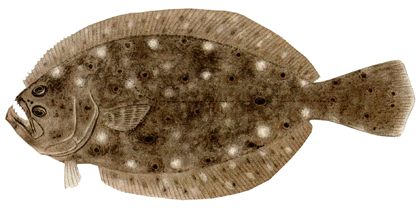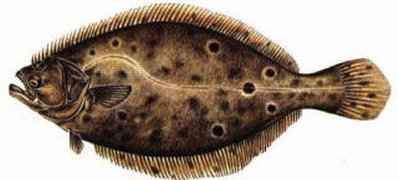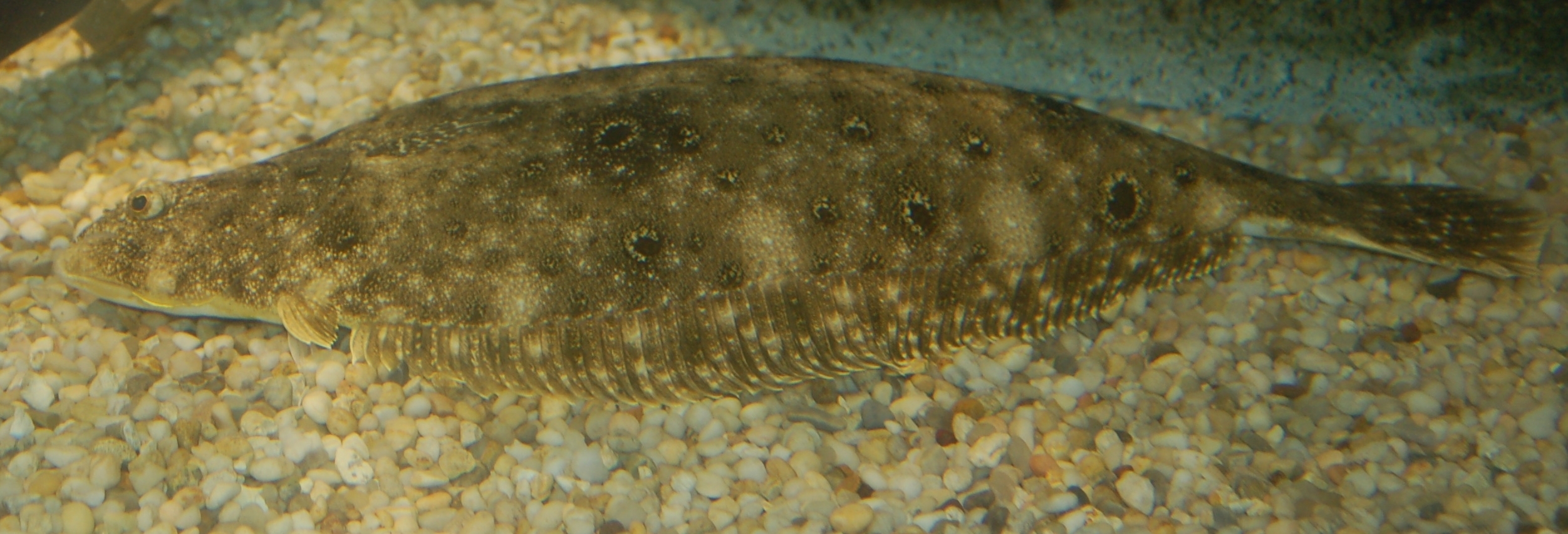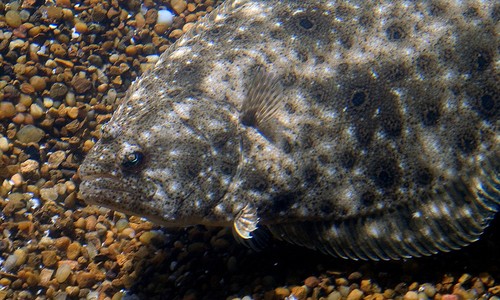
Paralichthys dentatus
FAMILY
Paralichthyidae
TAXONOMY
Pleuronectes dentatus Linnaeus, 1766, Carolina, United States.
OTHER COMMON NAMES
English: Fluke; French: Cardeau d’йtй; Spanish: Falso halibut
del Canadб.
PHYSICAL CHARACTERISTICS
Large, sinistral flatfish with a narrow, relatively elongate and
thick body. Prominent head with a large terminal mouth with a
wide gape and strong canine teeth on both jaws. A rounded or
doubly emarginate caudal fin. Eyes are relatively large, separated,
and nearly equal in position. Lateral line is arched above
the pectoral fin. Scales are small and cycloid, with secondary
squamation. Varies in coloration, as individuals change color to
match the background of their
HABITAT
. Ocular side coloration
ranges from drab olive-green to brown to gray; the blind side
usually is white. Individuals captured on white sand are nearly
completely white, whereas others on dark sediments can be
nearly black. Some individuals have pink, green, orange, or
brown coloration on the ocular side. The ocular side is marked
variously with irregular spots, often with a series of more or less
distinct ocelli that are slightly darker than the background coloration,
with the most posterior of these arranged in a double
triangle (one above and one below the lateral line). Males grow
to about 24 in (61 cm) in length, with a weight of 5.7 lb (2.6
kg), and females grow to about 37 in (94 cm) in length, with a
weight of 29.5 lb (13.4 kg). Most adults are 15.7–22 in (40–56
cm) in length and weigh between 2.2 and 5.1 lb (1.0–2.3 kg).
DISTRIBUTION
Western North Atlantic in estuarine and continental shelf waters
of eastern North America from Nova Scotia to Florida.
HABITAT
Inshore waters, including estuaries and even freshwater (juveniles),
bays, harbors, and the inner continental shelf. Summer flounder
prefer sandy or muddy bottoms, where they often are found in
sand patches near and within eelgrass beds or around pier pilings.
Sensitive to low oxygen concentrations and will move out of hypoxic
areas (less than 3 ppm oxygen). Concentrated inshore during
warmer periods of the year, with smaller fish found in very
shallow water. Larger fish in the northern part of the range occur
farther offshore, usually at depths of 230–509 ft (70–155 m) and
deeper, even during the summer. Estuaries are important nursery
areas for this species. Young summer flounder can withstand a
wide range of temperatures and salinity levels and are well
adapted for estuarine life. Juveniles remain in estuaries until their
second year of life in the southern part of their range, but to the
north they move just outside them during winter. Many young
fish return to the same estuary during their second summer.
BEHAVIOR
Spend most of their lives on or close to the bottom. Occur most
often on top of the sediment and do not ever bury deeply. Juveniles
may be active at night, but adults appear to be most active
during the daytime. Adults undertake strong seasonal inshoreoffshore
movements, especially in northern regions of the
species’ geographic range. Adults and juveniles are concentrated
in shallow coastal and estuarine waters during the warmer
months of the year and remain offshore in deeper waters (to
about 492 ft, or 150 m) in the fall and winter, presumably to escape
cold winter temperatures. Seasonal movements of summer
flounder are complicated and are affected by fish size, location,
and stock. Some may spend the winter in deeper bays and channels,
and older fish may remain permanently on the outer shelf.
FEEDING ECOLOGY AND DIET
Diurnally active, opportunistic ambush predators. They feed while
on the bottom but also rise off the bottom in pursuit of smaller
fishes. The primary food of summer flounder is bony fishes, but
cephalopods also are important prey of fish larger than 12.2 in (31
cm). Crustaceans, especially mysids and decapods, are important
prey for smaller fishes (those fish less than 8.3 in, or 21 cm). Juveniles
(3.9–7.9 in, or 10–20 cm) consume mysids, fishes, amphipods,
and crabs. Feeding is most active during warmer periods
and slows in winter. Spiny dogfish, blue sharks, skates, codfish
goosefish, sea robins, bluefish, and winter flounder prey on summer
flounder during various stages of their life history.
REPRODUCTIVE BIOLOGY
Male and female summer flounder mature at about 9.8 in (25 cm)
and 11 in (28 cm), respectively, corresponding to ages two and a
half years for females and two years for males. Many fish may
reach maturity at one year. Spawning occurs on or near the bottom,
where temperatures range from 53.6 to 66.2°F (12–19°C),
and usually takes place during the autumn migration to offshore
wintering grounds on the outer continental shelf. Large females
(more than 26.8 in, or 68 cm) may produce in excess of four million
eggs during a spawning season. Females are serial spawners,
continuously producing egg batches that are shed over a period of
several months (September to March). Larvae are transported to
coastal areas during winter and early spring by prevailing water
currents. Post-larvae and young juveniles are found in or near the
mouths of estuaries. Metamorphosis is completed within bays and
estuaries, where young fish settle to the bottom.
CONSERVATION STATUS
Not threatened. Exploitation of summer flounder by commercial
and recreational fishers resulted in stock reductions
throughout the species’ range during the latter quarter of the
past century. Fishery management plans have been developed
to conserve and rebuild stocks by limiting commercial and
recreational catches through size and season restrictions.
SIGNIFICANCE TO HUMANS
Summer flounder support the most important commercial and
recreational fishery for flatfishes along the Atlantic coast of the
United States. This highly prized game fish has strong fighting
qualities and is excellent table fare.
Photo Gallery of - Summer flounder





 Animalia Life
Animalia Life